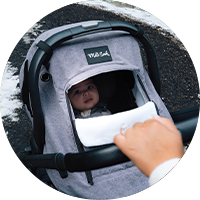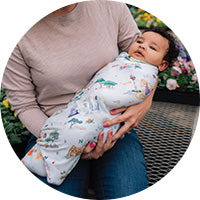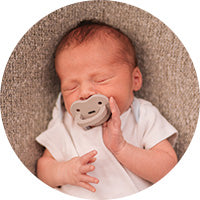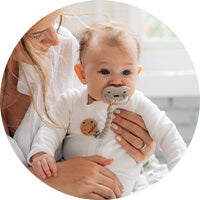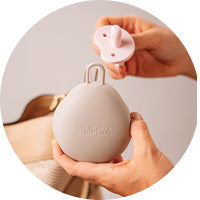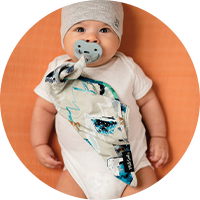Pacifiers and Teethers: Impact on Infant Dental Development and Choosing the Right Products
Teething is a major milestone in an infant's early life, but it often comes with some challenges like discomfort, fussiness, and changes in sleep and eating patterns. To ease these symptoms, parents frequently turn to pacifiers and teethers. However, it’s essential to recognize that not all pacifiers and teethers are equal. Using the wrong kind can affect your baby’s dental health and overall development. This guide will help you understand the impact of pacifiers and teethers on dental development and provide advice on choosing the right product during different stages of teething.
Understanding Teething and Its Challenges
Teething usually begins between 4 to 6 months, though it can vary for each baby. This process involves the gradual emergence of baby teeth through the gums, often causing discomfort. Common symptoms of teething include:
- Excessive drooling
- Irritability and fussiness
- Chewing on objects
- Swollen or tender gums
- Disrupted sleep
- Reduced appetite
While teething is a natural process, many parents turn to pacifiers, teethers, or other remedies for relief. However, it’s important to know how these products can impact your baby’s oral development and how to choose the best ones for each stage of teething.
The Role of Pacifiers in Dental Development
Infant Pacifiers are often used to calm and soothe, especially during the early months when babies have a strong need to suck for comfort. While pacifiers can be a lifesaver for both baby and parent, using them for too long or improperly can lead to dental issues as your baby grows.
Potential Impacts of Pacifiers on Dental Development
- Open Bite and Overbite: Prolonged pacifier use—especially after age 2 or 3—can cause the teeth to misalign, leading to conditions like open bite or overbite. This happens when the constant sucking motion pushes the front teeth outward, preventing the top and bottom teeth from meeting properly. This can later require orthodontic treatment to correct.
- Jaw and Palate Changes: Extended use of pacifiers can also affect the development of the jaw and palate, potentially causing the palate to narrow, which can result in more severe orthodontic issues down the road.
- Speech Development Delays: If pacifiers are used frequently into the toddler years, they may interfere with the development of oral muscles, delaying the practice of speech sounds and words. Babies need to strengthen their tongue and jaw muscles for talking, and excessive pacifier use can hinder this.
Despite these risks, using pacifiers during the first year of life has been linked to a reduced risk of Sudden Infant Death Syndrome (SIDS). The key is to use them wisely and wean your baby off pacifiers at the appropriate time to prevent dental complications.
Choosing the Right Pacifier for Your Baby
Selecting the right pacifier is crucial to your baby’s dental health. Here are some tips for choosing pacifiers during the newborn and teething stages:
- Orthodontic Pacifiers: These are designed to support natural tongue movement and reduce pressure on the baby’s gums and teeth. Orthodontic pacifiers have a flattened bottom and a rounded top, mimicking the shape of a nipple, which makes them a better choice for long-term use.
- Material and Size: Always choose BPA-free silicone or latex pacifiers. Make sure the size is appropriate for your baby’s age. Newborn pacifiers are smaller and softer, while older babies need pacifiers designed for their stage of development.
- Ventilated Shield: Pacifiers with a shield that has ventilation holes help prevent skin irritation around the mouth and allow air to circulate, which reduces the risk of infection or discomfort.
- Stage-Specific Designs: As babies grow, their needs change. Teething babies may prefer pacifiers with textured surfaces that can soothe their sore gums, so it’s important to switch to a pacifier that aligns with your baby’s stage of development.
Teethers and Their Role in Dental Development
Teethers are a popular go-to for parents during teething. They offer much-needed relief by giving babies something to chew on, which helps massage sore gums and can speed up the process of teeth breaking through. However, choosing the wrong type of teether can inadvertently cause discomfort or even harm to your baby’s gums and teeth.
Potential Impacts of Teethers on Dental Development
- Promoting Healthy Gum Development: Teethers provide a safe outlet for babies to chew, which not only soothes gum pain but also helps promote the healthy growth of gum tissue. The chewing action also encourages baby teeth to come in properly.
- Supporting Jaw Muscle Growth: Chewing on teethers helps strengthen a baby’s jaw muscles, which is important for both future chewing and speech development.
- Avoiding Harmful Designs: Some teethers can be too hard or poorly shaped, placing unnecessary pressure on a baby’s gums or developing teeth. It's important to choose age-appropriate and properly designed teethers to avoid causing discomfort or even damaging gum tissue.
Choosing the Right Teether for Your Baby
Selecting a good teether involves considering its material, shape, and functionality. Here are a few things to keep in mind when choosing a teether:
- BPA-Free and Non-Toxic Materials: Always opt for teethers made from safe, non-toxic materials like BPA-free silicone or natural rubber. These are safer for your baby and durable enough to withstand constant chewing.
- Textured Surfaces: Look for teethers with varying textures, such as soft bumps or ridges, which can help soothe sore gums by gently massaging them as the baby chews.
- Appropriate Hardness: Teethers should be firm but not too hard. A teether that’s too rigid can hurt sensitive gums, while one that’s too soft may not provide enough relief.
- Cooling Teethers: Some teethers can be cooled in the refrigerator for extra relief. However, avoid freezing teethers, as extreme cold can damage your baby’s gums.
Balancing Pacifier and Teether Use
Using both pacifiers and teethers appropriately can provide comfort and support your baby’s development while minimizing the risk of dental issues. Here’s a general guideline for balancing their use:
- Newborn Stage (0-6 months): Pacifiers are helpful for soothing during this stage, especially for sleep. Be sure to use an orthodontic pacifier to minimize the impact on dental development. Teething is less of a concern at this point, but gentle gum massagers can prepare the gums.
- Teething Stage (6-24 months): As your baby starts teething, transition to soft, textured teethers to help soothe discomfort. At the same time, begin to gradually reduce pacifier use, especially as the first teeth start to appear, to prevent dental issues like open bite or overbite.
Conclusion
Pacifiers and teethers are valuable tools for soothing and helping babies through the teething process, but they also play a significant role in dental development. Choosing the Milk Snob's right products based on your baby’s age and teething stage can ensure both comfort and healthy oral development. From orthodontic pacifiers for newborns to thoughtfully designed teethers for teething infants, making informed decisions will help lay the foundation for your child’s long-term dental health.





